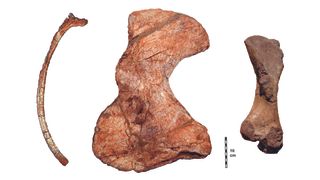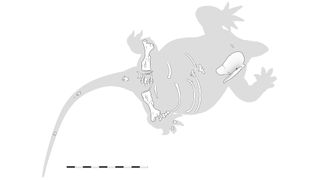The ancestors of mammals looked like fat lizards with small heads and had a hippo-like lifestyle
Animals that lived before the dinosaurs looked like fat lizards with very small heads and had a semi-aquatic lifestyle like that of a hippopotamus, according to fossils recently unearthed in France.
The amphibians, which represent a previously unknown genus and species of mammal ancestor, measure about 12 feet (4 meters) in length, the researchers report in the October issue of the journal. Palaeo Vertebrates, published online in July. They dub a new species Lalieudorhynchus gandi; it lived about 265 million years ago in Pangea supercontinent, just before the era of the dinosaurs.
The unusual animal fossil was first discovered in 2001 in the Lodève Basin in southern France, by study co-author and paleontologist Jörg Schneider, a professor in the Department of Paleontology and Stratigraphy at the University of Freiberg in Germany, and doctoral candidate Frank Körner. They found two large ribs, each measuring 24 inches (60 centimeters) long, in a rocky riverbed. During subsequent visits to the site, Körner discovered additional bones from the mysterious animal: a femur measuring 14 inches (35 cm) long, and a shoulder blade measuring 20 inches (50 cm).
Their analysis spanned 20 years, largely because the fossils were encased in hard sandstone and their preparation took years to complete, the researchers report in the study.
From this partially but well-preserved skeleton, paleontologists have concluded that the primitive creature was a type of caseid — an extinct group of fossilized reptiles with mammalian characteristics and thought to be the ancestors of mammals — in the genus Lalieudorhynchus. Described in a press release as a “fat lizard” and as a 3.5-meter-long “heap of flesh”, the creature lived during the Permian, a period that began about 299 million years ago and ended about 252 million years ago with the start of the Triassic (and appearance dinosaur).
Related: The ancient hippo-sized reptile is a fast and fierce killing machine
(opens in a new tab)
Caseids are primarily herbivores – perhaps some of the earliest herbivores in evolutionary history. They has a small head and barrel-shaped body which holds a large digestive tract for destroying plants, and despite their reptilian appearance, caseids are the ancestors of mammals. .
“This highly diverse group of mammal ancestors was the dominant group before the age of the dinosaurs,” Frederik Spindler, study co-author and scientific director at the Altmühltal Dinosaur Museum in Denkendorf, Germany, told Live Science. When Spindler examined the newly discovered fossils, he concluded that they belonged to a new species. There are fewer than 20 identified caseid species in the fossil record to date; most are from the United States and Russia, but some have recently been discovered in southern Europe, Spindler said.
(opens in a new tab)
However, L. gandi could be a highly developed caseid species, unlike previously seen, Spindler added. “New genera diagnosed by detailed anatomical comparison,” and analysis on L. gandi conducted by study lead author Ralf Werneburg, director of the Natural History Museum at Bertholdsburg Castle in Schleusingen, Germany, Spindler said. Werneburg identified five unique features “not known in other caseids, and another 20 that make up unique combinations in this family,” Spindler explained.
This newly identified creature is not the so-called missing link in the evolutionary lineage of the mammalian family tree, but its status as one of the youngest caseids ever discovered may be important to understanding mammals. evolution. “This increases the diversity of known large caseids, marking them as a very important group of herbivores,” Spindler said. Especially, L. gandi could be an evolutionary culmination for all caseids before extinction, meaning that the species had the most advanced features in the group, Spindler said.
Structure of L. gandiThe bones, which are supple and flexible when viewed under a microscope, suggest to the study authors that ancient caseids may have led a semi-aquatic lifestyle, like the modern one. hippopotamus. In life, L. gandi it likely weighed hundreds of pounds, and all that weight may require the extra support of submersion in water, according to research.
However, L. gandi not a relative of the hippopotamus, and any resemblance to modern hippos lies in the ancient animal’s habits and not its anatomy, Spindler said.
“Sponge bones may imply a diving lifestyle in some extinct marine amphibians and reptiles,” Spindler said. In comparison, most mammals – including hippos – have denser bone tissue. “Our new caseid will swim better, whereas the hippo will walk closer to the ground,” Spindler said.
“The low-exploration semiaquatic lifestyle is what the big caseid shares with the hippopotamus, if we’re right,” Spindler said. One can say that Lalieudorhynchus gandi ‘find’ the niche that the hippopotamus repeats later.”
Originally published in Live Science.
#ancestors #mammals #looked #fat #lizards #small #heads #hippolike #lifestyle


Comments
Post a Comment